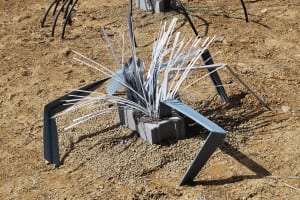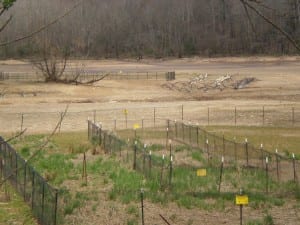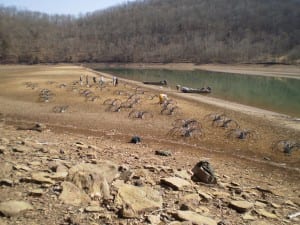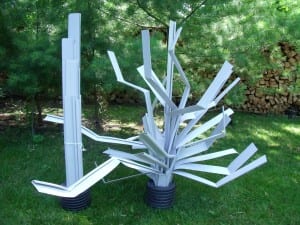 If you want to grow and sustain your fishery, then you have to expand the habitat for fish to reproduce and grow large. This is nothing new for the fisherman involved in the B.A.S.S. Federation Nation of West Virginia. These guys have been involved in habitat restoration projects from the beginning, leading the way for future generations of fish and fisherman to grow and prosper.
If you want to grow and sustain your fishery, then you have to expand the habitat for fish to reproduce and grow large. This is nothing new for the fisherman involved in the B.A.S.S. Federation Nation of West Virginia. These guys have been involved in habitat restoration projects from the beginning, leading the way for future generations of fish and fisherman to grow and prosper.
A few short weeks ago, Jerod Harman, Conservation Director for the West Virginia B.A.S.S.Federation Nation, contacted the owner of Fishiding artificial habitats. Jerod saw the benefits of these reclaimed PVC structures and asked about working together to help them in their ongoing efforts to improve fish habitat on a few of their local lakes.
See the dozens of unique artificial fish habitat models, fish attractors and fish cover used at fishiding.com, the leader in proven science based, fish protection.
Fishiding habitat products had been recently been awarded at the Bassmasters Classic Conservation Summit in Shreveport,LA. Jerod, a long time steward of B.A.S.S knew these reclaimed structures would help achieve their habitat goals, complimenting the “Spider Blocks” he is so well known for installing. Jerod has a long time relationship with local Corps of Engineer leaders and the DNR in his outstanding state. Having worked with them for many years on multiple restoration projects, his reputation is well known for rounding up the troops and getting the job done in an utmost professional and timely manner. Field and Stream magazine has also highlighted his work in a recent issue, honoring him as one of our Nation’s “Hero’s of Conservation” for his habitat work.
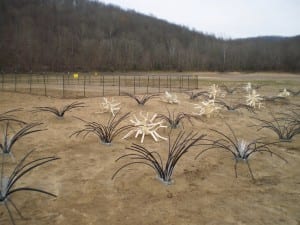 When the local lakes are drawn down for the winter, Jerod and his dedicated team of volunteers spring into action when most of us are sitting by a warm fire. The exposed lake bed gives them the opportunity to get right into the fishes’ favorite breeding grounds and begin to work their magic. In past years, the group has braved snow, ice and freezing temperatures to work on structures to provide habitat that is either lacking, has deteriorated or washed away by flooding. The group typically works with artificial structures that will last for many years to come, since they never rot or decompose like other types of natural products. They also install native plants and protect them from predators until they have a chance to take hold.
When the local lakes are drawn down for the winter, Jerod and his dedicated team of volunteers spring into action when most of us are sitting by a warm fire. The exposed lake bed gives them the opportunity to get right into the fishes’ favorite breeding grounds and begin to work their magic. In past years, the group has braved snow, ice and freezing temperatures to work on structures to provide habitat that is either lacking, has deteriorated or washed away by flooding. The group typically works with artificial structures that will last for many years to come, since they never rot or decompose like other types of natural products. They also install native plants and protect them from predators until they have a chance to take hold.
Jim Summers is another name synonymous with habitat. Jim has worked on these types of projects for many years and now takes credit for the fine photos we have to enjoy. Jim is always on hand to help, as well as get the shots as the work progresses. Some of the WVDNR staff put on their wet suits on their own time to get the underwater pictures of the spider block structures after they had time to age. The proof is in the pictures, showing not only bass, but forage species utilizing the new habitat the group has provided and installed.
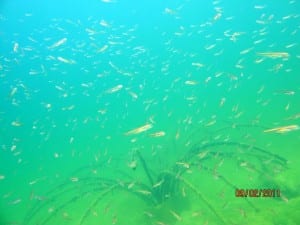
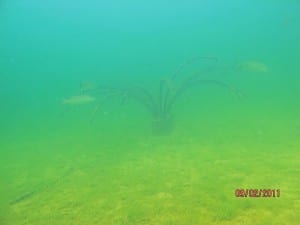 The key to the effectiveness of artificial fish habitat, is the ability to grow bio film or periphyton. This film forms on inert substrates and begins the cycle of life which attracts invertebrates and larger fish to feed on. Other aspects that hold these types of structure units above the rest is that they don’t decompose, therefore not using up important dissolved oxygen from the water column as they rot. Bio film is proven to be the highest form of fish food, better than any commercial feeds on the market today. The bio film consumes over abundant nutrients like phosphorous, brought in by runoff which causes excessive algae growth in many lakes and ponds. The fish then eat this high energy food and grow even larger, at an unmatched rate to boot! A company leading this technology is Floating Islands International,Inc out of Montana. These islands made from recycled plastics form a matrix of fibers, creating maximum surface area to grow this bio film. Not only do these products feed the fish, but they cleanse the water and drastically improve water clarity.
The key to the effectiveness of artificial fish habitat, is the ability to grow bio film or periphyton. This film forms on inert substrates and begins the cycle of life which attracts invertebrates and larger fish to feed on. Other aspects that hold these types of structure units above the rest is that they don’t decompose, therefore not using up important dissolved oxygen from the water column as they rot. Bio film is proven to be the highest form of fish food, better than any commercial feeds on the market today. The bio film consumes over abundant nutrients like phosphorous, brought in by runoff which causes excessive algae growth in many lakes and ponds. The fish then eat this high energy food and grow even larger, at an unmatched rate to boot! A company leading this technology is Floating Islands International,Inc out of Montana. These islands made from recycled plastics form a matrix of fibers, creating maximum surface area to grow this bio film. Not only do these products feed the fish, but they cleanse the water and drastically improve water clarity.
 Generally, the group of volunteers will install 50-75 habitat units per outing. Much of the supplies are donated by local companies, providing pipe, cinder blocks and cement. Some of the funds are received from state and federal grants, to provide plant stock and professional help as well. The bulk of the effort comes from volunteer labor, provided by Jerod and his dedicated group of conservation minded members. Without folks like these, our grand kids would not have the opportunity to enjoy what we have been so blessed to enjoy for so many years.
Generally, the group of volunteers will install 50-75 habitat units per outing. Much of the supplies are donated by local companies, providing pipe, cinder blocks and cement. Some of the funds are received from state and federal grants, to provide plant stock and professional help as well. The bulk of the effort comes from volunteer labor, provided by Jerod and his dedicated group of conservation minded members. Without folks like these, our grand kids would not have the opportunity to enjoy what we have been so blessed to enjoy for so many years.
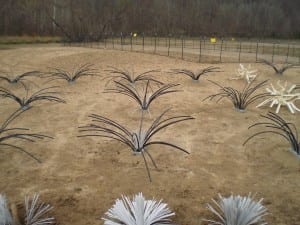 The most recent projects involving the donated fishiding structures were put in Lake Summersville and Sutton Lake. These two area lakes will benefit in many ways from the Federation’s efforts. Spider Blocks, along with Keeper, Safehouse and shallow Cradle models all work together near new bullrush and arrow anum plantings to provide ultimate spawning areas.
The most recent projects involving the donated fishiding structures were put in Lake Summersville and Sutton Lake. These two area lakes will benefit in many ways from the Federation’s efforts. Spider Blocks, along with Keeper, Safehouse and shallow Cradle models all work together near new bullrush and arrow anum plantings to provide ultimate spawning areas.
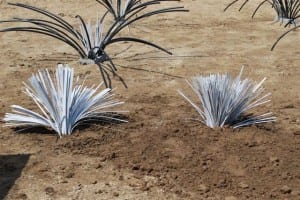 1800 plants were added to Sutton lake by volunteers from the WVBFN as well as local DNR officials and staff. David Truban, a West Virginia DNR commisioner was also on hand to bend a few Fishiding structures too. Jerod told Dave, “Just think like a fish and have at it” He was pleased to put his twist on making one into a fantastic looking block! ” I honestly believe that this project will make huge a difference in this area of the lake because of the diversity of habitat that they will have at theit disposal. “If I were a bass, this is where I would want to call home”
1800 plants were added to Sutton lake by volunteers from the WVBFN as well as local DNR officials and staff. David Truban, a West Virginia DNR commisioner was also on hand to bend a few Fishiding structures too. Jerod told Dave, “Just think like a fish and have at it” He was pleased to put his twist on making one into a fantastic looking block! ” I honestly believe that this project will make huge a difference in this area of the lake because of the diversity of habitat that they will have at theit disposal. “If I were a bass, this is where I would want to call home”
“I really don’t see us doing projects in the future without artificial structures mixed in. No matter what the weather conditions are, they are an investment that will be there through freezing, drought, high water, just about anything barring a massive flood in which they would be washed out. And even then, they will just be redistributed for cover somewhere else. ” Jerod Harman.
Working with the WVBFN has been an absolute pleasure. Cribs were sent out to the guys early in the week and by the weekend, they were in place ready for the water to rise. Others can take note of the dedicated members, the communities involvement and the ongoing positive relationship formed with the local governing agencies. These fish will prosper from their combined efforts, ultimately providing fisherman with a vast variety of cover and species to target.
For more information about the WVBFN and it’s affiliates you can go to their website at http://www.wvabassfederationnation.com . To get involved in their habitat efforts you can contact Jerod Harman at jharman12@cebridge.net
